Bulletin – June 2016 Australian Economy The Growth of Apartment Construction in Australia
- Download the article 336KB
Abstract
Apartments have become an increasingly important contributor to new dwelling construction over recent years and in 2015 accounted for more than one-third of all residential building approvals. The majority of recent apartment construction has been located in Sydney, Melbourne and Brisbane. Across these cities there have been differences in geographical concentration, the types of buyers purchasing the dwellings and supply-side factors such as planning frameworks. The increase in apartment construction has reflected a range of factors, including the nature of land supply constraints and affordability considerations, together with a desire to reside in close proximity to employment centres and amenities. Given that these factors are likely to persist, apartments are expected to continue to play an important role in providing new housing supply.
Introduction
The number of residential houses and apartments built each year in Australia cycled around a flat trend over the 15 years to 2009. Since then, total residential building approvals have increased noticeably. High-density apartments have accounted for most of this increase, such that, by 2015, apartments accounted for one-third of all residential building approvals. This strong volume of apartment construction has made a significant contribution to economic growth and employment.
The majority of the new apartments have been built in the most populous cities and primarily near inner-city areas or close to transport infrastructure. The increase in apartment construction has delivered many dwellings that are less expensive than larger, lower-density housing. They are mostly in areas that are well connected with amenities and employment centres.
This article discusses recent activity in apartment construction, the different characteristics that have emerged in markets across the larger capital cities and the factors that have increased apartments as a share of the housing stock. The main focus of this article is on Sydney, Melbourne and Brisbane, given that these three cities have accounted for more than three-quarters of apartment approvals since 2011. As part of its business liaison program, the Reserve Bank meets regularly with a wide range of apartment developers, state and local government agencies and housing industry associations across the country; the information gathered during liaison has helped inform this article.[1]
Recent Activity
After remaining steady for an extended period, apartment construction increased strongly from 2009 onwards (Graph 1). This increase has been concentrated in Australia's three most populous capital cities – Sydney, Melbourne and Brisbane. Initially, approvals for apartments increased in Melbourne in 2010, followed by Sydney, and then Brisbane more recently (Graph 2). Apartment approvals in Perth also increased in recent years, but from a relatively small base. The effect of this increase on the stock of apartments in each city has varied. Cumulative approvals since 2011 in Melbourne and Brisbane have added around one-third to the stock of apartments in those cities compared with an addition of around one-fifth of the 2011 stock for Sydney and Perth (Table 1).
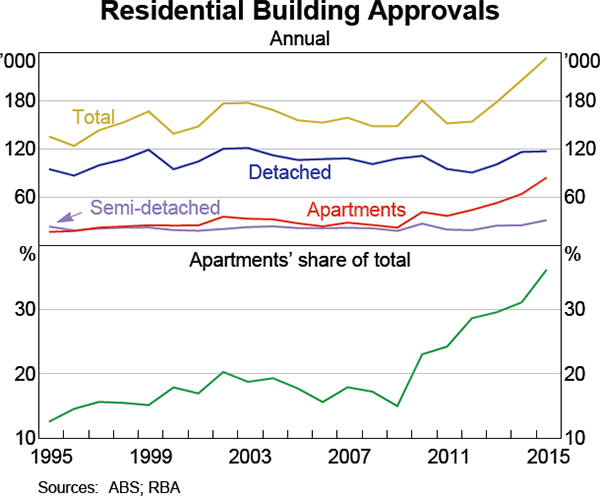
The location of activity within each of the cities has varied. This has been determined by a variety of factors, including proximity to employment centres and transport infrastructure, planning frameworks and the availability of suitable sites for apartment projects. In Sydney, approvals have been relatively spread out across the inner and middle suburbs – a large area ranging from Parramatta in the west to Chatswood in the north and Mascot in the south (Graph 3). In contrast, a relatively large share of apartment approvals in Melbourne has been in the city (which includes the CBD, Southbank and Docklands – an area of around 30 square kilometres), although construction activity in the middle-ring suburbs has picked up more recently. In Brisbane, activity has been concentrated in the city and in a few of the surrounding inner suburbs, as has been the case in Perth.
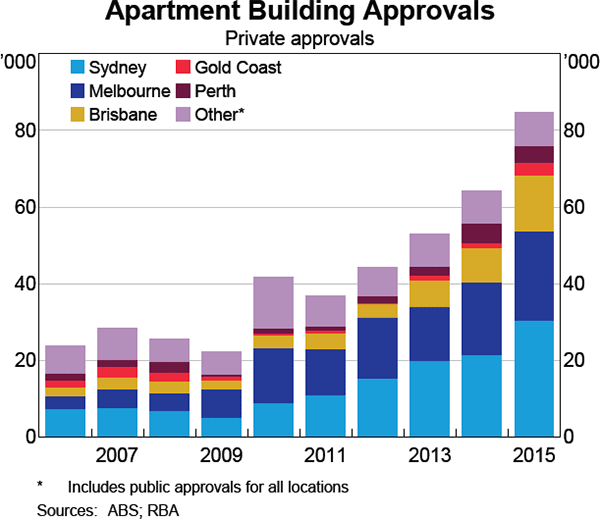
Alongside this strong construction activity, competition among developers for suitable sites for apartment projects has intensified and led to increases in site prices. Australian developers account for the majority of apartment projects, though foreign developers have become more active in acquiring sites and developing projects, mostly in Melbourne and Sydney.[2] In addition to competing over the acquisition of suitable new sites and residential land, developers have also sought to purchase lower-grade office and industrial buildings for conversion into apartment projects, thereby supporting prices for these assets.
| Apartment stock As at September 2011 | Building approvals Total: 2012 to 2015 | ||
|---|---|---|---|
| ′000 | ′000 | Per cent of 2011 stock | |
| Sydney | 434 | 78 | 18 |
| Melbourne | 224 | 68 | 30 |
| Brisbane | 83 | 30 | 36 |
| Perth(a) | 71 | 14 | 20 |
|
(a) Includes outer suburbs Sources: ABS; RBA |
|||
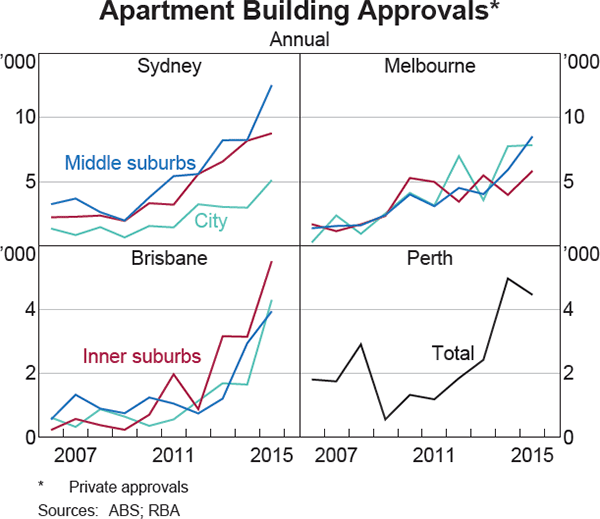
Buyers of Apartments
There are a variety of factors that have contributed to increased demand for new apartments from prospective owners and tenants. Employment opportunities and population growth are fundamental drivers of demand for new housing; sustained population growth in Australia's largest cities has led to increased demand for all dwellings, including apartments (Graph 4 and Graph 5). Population growth was strongest in Perth for much of the past decade, in part owing to migration associated with the mining investment boom. That growth has slowed over the past couple of years.
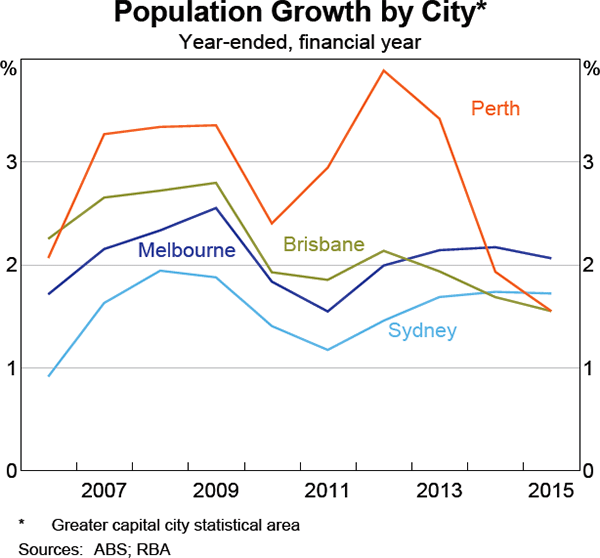
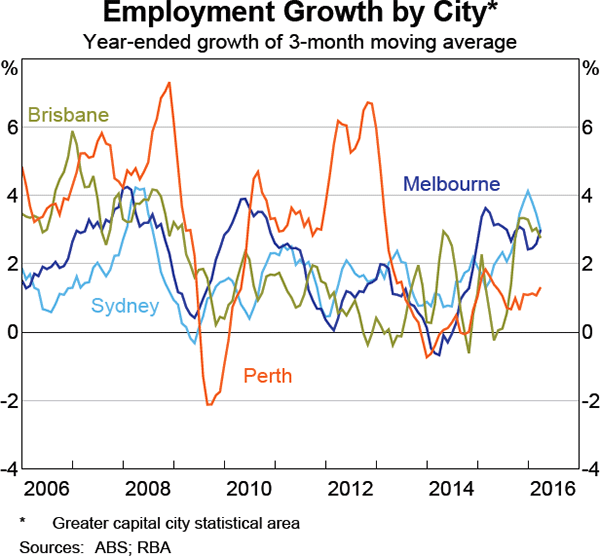
In the eastern cities, land supply constraints have led to increased prices for blocks of land and detached houses. This is likely to have driven demand for apartments relative to other dwellings, as apartments use land more intensively than detached houses and are therefore relatively more affordable. A desire to reside close to CBD employment centres is also likely to have stimulated demand for apartments, as residents in increasingly populated cities value the convenience and reduced travel time associated with the proximity to amenities in these areas.
Three types of buyers can be distinguished – owner-occupiers, domestic investors and foreign buyers (‘non-residents’).[3] Liaison with industry contacts suggests that, in recent years, the relative importance of these three groups has varied across different cities. Foreign buyers have played a relatively significant role in the inner city of Melbourne. In the inner suburbs of Brisbane, domestic investors (particularly from interstate) have underpinned demand, driven in part by the higher yields available relative to Sydney and Melbourne. In contrast, sales in Sydney have been more evenly spread across the three groups of buyers.
Whether buyers are owner-occupiers or investors can influence the composition of the net supply of housing. Purchases of new apartments by domestic investors are most likely to lead to an increase in the supply of rental properties. For owner-occupiers, the net effect will depend on the location and size of the existing property from which the purchaser is moving and whether there is a change in the rate of household formation. For example, if the owner-occupier is a first home buyer moving out of their parents' home, total demand for housing increases alongside the increased supply of housing, whereas if they are moving from a rented property this will create a rental vacancy elsewhere. Similarly, owner-occupiers who are downsizing will leave an established property that can possibly accommodate a larger household. The net impact from foreign buyers on housing demand will depend on the relative mix of those buyers who plan to occupy their dwelling (or leave it vacant) and those who plan to rent out their property.
Industry contacts have often reported that many foreign buyers, especially those who reside in East Asia, have additional motivations for buying apartments in Australia. It is commonly reported that foreign buyers purchase Australian property to diversify their wealth and intend to hold the property for a long period. Contacts also suggest that foreign buyers' motivations can include the prospect of future migration, providing housing for children while they study in Australia, or acquiring holiday apartments. The interest from foreign buyers of property, particularly those from Asia, is not unique to Australia; such buyers are also active in the property markets in other countries, such as the United States, the United Kingdom, Canada and New Zealand. Other features that have been cited as attracting foreign buyers include the lower prices of apartments in Australia in recent years relative to major cities in some other countries (particularly following the depreciation of the Australian dollar), geographic proximity to Asia and a stable political and regulatory environment.
Supply-side Factors
There are several factors that have affected how apartment supply has responded to increased demand over recent years. Liaison with industry contacts suggests that the most significant supply-side factors for new apartment construction are the time and complexity associated with obtaining approval to develop a project, and the availability of suitable sites.[4] The nature of these factors has also varied across the larger capital cities.
There are a number of stages involved in constructing an apartment project, lasting several years from the initial selection of a site to the completion of the project (Table 2). After purchasing a site, a developer must submit a development application (DA) to the relevant authority (normally a state government planning department or a local council). That authority assesses the application in the context of zoning regulations and community input. If approved, the developer will typically then market the project and seek to achieve a given share of off-the-plan apartment sales (‘pre-sales’) required to secure financing. A permit to commence construction – the building approval (BA) – is then provided by the relevant authority and, finally, construction takes place.[5]
| Stage 1 | Stage 2 | Stage 3 | Stage 4 | Stage 5 | Stage 6 |
|---|---|---|---|---|---|
| Pre-DA: Site selection, design and prepare DA | DA: Authority assesses DA for approval (may involve community input, appeals, DA amendments, zoning changes) | Financing and marketing: advertise dwellings, secure pre-sales and financing | BA: Receive permit to proceed with construction (building approval generally recorded by ABS) | Construction | Settlement (owners or tenants can occupy apartments) |
|
Source: various liaison contacts |
|||||
The DA approval process differs across cities and influences the number and scale of apartment projects, and the speed with which new supply responds to demand. Liaison with industry contacts suggests that a more centralised approvals framework, such as where the state government planning department is responsible for assessing the DA, generally facilitates a quicker response compared with situations where local councils make the decision.
A centralised process is sometimes applicable in cases of large or high-value projects. For instance, the Victorian Minister for Planning is responsible for assessing projects in the City of Melbourne with a floor space exceeding 25,000 square metres. Industry contacts have reported that this has contributed to the strong increase of building activity in inner-city Melbourne, with this approach applying to a large proportion of apartment projects commenced in recent years. In Sydney, a centralised framework applies to a smaller share of projects – the New South Wales Minister for Planning generally only assesses projects located in designated large-scale urban renewal sites (Barangaroo, for example). The process in Brisbane is largely centralised, where the Brisbane City Council has been responsible for approving most large projects over recent years. The Brisbane City Council also applies a streamlined framework – ‘code assessment’ – to many large high-rise projects. Under this framework, DAs that comply with the relevant development and planning codes (such as land-use zones and maximum heights) can be assessed without requiring specific community consultation, potentially shortening the approvals process significantly. By comparison, industry contacts have generally reported that in areas where the framework is more decentralised, such as the inner and middle suburbs of Sydney and Melbourne, the approvals process is often longer and the supply response more gradual.
Zoning regulations also affect the approvals process, particularly outside CBDs. Generally, DAs cannot be assessed if they do not comply with the existing land-use zones set by councils. In these cases, the developer must apply to have the zone changed, which is often a lengthy and costly process. Zoning restrictions also affect the availability and pricing of sites because projects located on sites that are already zoned appropriately for apartment developments can be approved more easily.
Financing Arrangements
Most developers rely on some form of intermediated financing to ensure projects progress through to the end of the construction phase. While some developers will fund projects entirely with equity, a typical developer will seek bank finance for at least half of the total cost of construction and they will possibly source mezzanine finance to reduce the equity component required.[6] As mentioned earlier, banks impose pre-sales requirements on developers before funding is made available; these requirements vary by market and lender, though generally now cover at least the value of the debt being sought. Australian banks also typically cap the share of a developer's pre-sales that can be accounted for by non-residents, generally at between one-fifth and one-third of the value of debt obtained. Equity-funded developers will also often seek a large share of pre-sales before proceeding with construction, particularly for larger projects. Foreign developers appear to follow a similar model to domestic developers, although some of their bank funding comes from banks resident in their home country, including the Australian branches of foreign banks. Although Australian-owned banks do lend to foreign developers, this is generally to long-standing customers or occasionally taking the lead on syndicated deals in which foreign banks provide a larger share of the funding or take the first exposure to credit losses.
When an individual buys an apartment off the plan (i.e. signs a contract to purchase and provide a deposit, which is usually 10 per cent of the sale price), they may seek pre-approval from their financial institution for debt financing. However, the financial institution does not formally assess debt serviceability or provide unconditional financing approval until settlement is ready to take place. The lender will typically use an estimated valuation for the property to determine the amount of debt that it will provide to the borrower. These financing arrangements typically will be finalised at the time of completion of the development, which is often two to three years after the initial agreement to purchase. If the amount the lender is willing to lend is significantly less than the purchaser expected when they entered into the off-the-plan contract, the purchaser may be unable or unwilling to settle, in which case they would be liable to forfeit their deposit. This settlement risk is magnified if prices (for similar apartments) have declined over the development period (leading to valuation below the purchase price) or if the buyer's financial position has deteriorated (in the event of unemployment, for example). Instances of buyers failing to settle their apartment purchase – settlement failures – can affect the financial position and credit risk of apartment developers, leading to potential losses for lenders.
Financing arrangements and loan-to-valuation ratios (LVRs) vary among different types of buyers. For instance, downsizers and other existing home owners will typically provide more equity than first home buyers and, as such, require a smaller proportion of debt financing from a bank. Lenders also tend to impose lower LVR limits on investors than on owner-occupiers, which means that investors must provide relatively more equity. It is often reported that foreign buyers of apartments in Australia typically finance their purchase with more equity than domestic buyers. Australian-owned banks have traditionally engaged in some lending to non-residents to purchase Australian apartments, but the amounts have been small relative to their total mortgage books. Australian-owned banks also applied tighter lending standards to non-residents than domestic borrowers because it was more difficult to verify the income and other details of foreign buyers, and the banks may have less recourse to these borrowers' assets in the event of default. Australian branches of foreign-owned banks are known to extend financing to foreign buyers, particularly to those from the same resident country.
Current Market Conditions
Liaison with industry contacts suggests that demand for new apartments generally remains strong, but appears to have eased in some markets over recent quarters. This has primarily reflected weaker demand by domestic investors, together with tighter lending standards on mortgages implemented by financial institutions and a moderation of expectations for price increases. Sales to foreign buyers (particularly in Sydney and Melbourne) have reportedly remained at a high level. Reports from liaison suggest that demand for apartments has weakened the most in Perth, consistent with the slowing of economic activity and decline in population growth in Western Australia.
Australian-owned lending institutions have reportedly tightened financing conditions for both developers of apartment projects and buyers of apartments. This tightening has been ongoing for some time as banks have sought to control the risk of their exposure to the sector, particularly in areas where there is a sizeable pipeline of supply, and comply with supervisory actions introduced from late 2014. More recently, the large Australian banks have also tightened or ceased lending to foreign buyers seeking mortgages. Despite tightened financing conditions for buyers, developers and financial institutions have both reported that instances in which purchasers of off-the-plan apartments have failed to settle their purchase remain uncommon to date.
Measured prices and rents for apartments in Sydney and Melbourne have either grown or remained relatively stable for much of this decade, despite large additions to supply in these markets (Graph 6). Prices and rents in Sydney have shown the strongest growth, which is consistent with the smaller volume of new apartments (built, in progress or planned) relative to the existing stock. In contrast, Perth has recorded notable declines in prices and rents in recent years, alongside a weakening local economy. More recently, growth in rents and prices has also weakened somewhat in Brisbane.
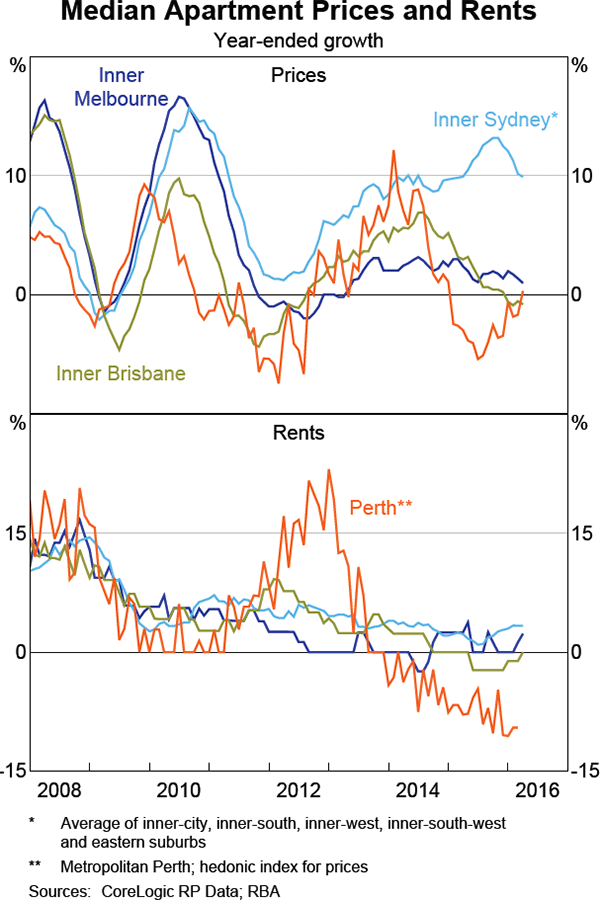
Conclusion
Apartments have driven the increase in new dwelling construction in Australia since 2010 and have provided an important contribution to economic growth and employment. The increase in apartment construction has reflected a range of factors, including land supply constraints, affordability considerations and a desire to reside in close proximity to established amenities and employment centres. This has delivered many new dwellings to the market, which has had an effect on housing prices and rents, with growth in these indicators slowing of late. The majority of recent activity has been located in areas with existing links to transport, infrastructure and services, particularly the inner suburbs of Sydney, Melbourne and Brisbane, and, to a lesser degree, Perth. The increase in apartment construction in these cities has been characterised by differences in the geographical concentration of activity, the proportional increase in the apartment stock, the types of buyers purchasing the new dwellings and the planning frameworks, which can affect the behaviour of developers and the supply response. Apartments are likely to continue to play an important role in providing new housing as land supply constraints motivate prospective home owners to purchase higher-density dwellings (which use land more intensively and are therefore less expensive relative to larger, lower-density houses), and as tenants and residents choose to live closer to employment centres and amenities for convenience.
Footnotes
The author is from Economic Analysis Department. [*]
The Reserve Bank business liaison team conducts around 70–80 discussions monthly with different contacts. Discussions with any individual firm typically occur around every 6 to 12 months, with Bank staff usually meeting the chief executive officer, chief financial officer and/or operations manager. Liaison meetings are held nationally with firms of all sizes, although most discussions are with mid-sized and large firms, where conditions are somewhat more likely to reflect economy-wide trends rather than firm-specific factors. For more information, see RBA (2014). [1]
Foreign investment in Australian residential dwellings and commercial property (from both buyers seeking dwellings and developers intending to construct projects) has increased in recent years. See RBA (2016) for a description of Chinese investment in Australian property and a discussion of the potential implications for financial stability. [2]
All foreign buyers, other than temporary residents, are generally restricted to purchasing newly constructed dwellings. The observations on foreign buyer activity in this article are sourced from liaison with property developers and other industry contacts. Developers must record the residency of buyers to ensure that they do not exceed Australian banks' caps on pre-sales to foreign buyers (if funded by an Australian lender). Non-residents and temporary residents must apply to purchase Australian property – the Foreign Investment Review Board records data on approvals for these purchases, though these data are limited and partial. For a detailed discussion of the data limitations, see Gauder, Houssard and Orsmond (2014) and RBA (2016). [3]
See Hsieh, Norman and Orsmond (2012) for a detailed description of supply factors in the housing sector. [4]
The ABS generally records a building approval once a construction permit has been granted. [5]
Mezzanine finance is debt that is subordinated to that provided by the bank or senior lender, but ranks ahead of the equity provided by the developer in the event of default. [6]
References
Gauder M, C Houssard and D Orsmond (2014), ‘Foreign Investment in Residential Real Estate’, RBA Bulletin, June, pp 11–18.
Hsieh W, D Norman and D Orsmond (2012), ‘Supply-side Issues in the Housing Sector’, RBA Bulletin, September, pp 11–19.
RBA (Reserve Bank of Australia) (2014), ‘The RBA's Business Liaison Program’, RBA Bulletin, September, pp 1–5.
RBA (2016), ‘Box B: Chinese Demand for Australian Property’, Financial Stability Review, April, pp 30–32.